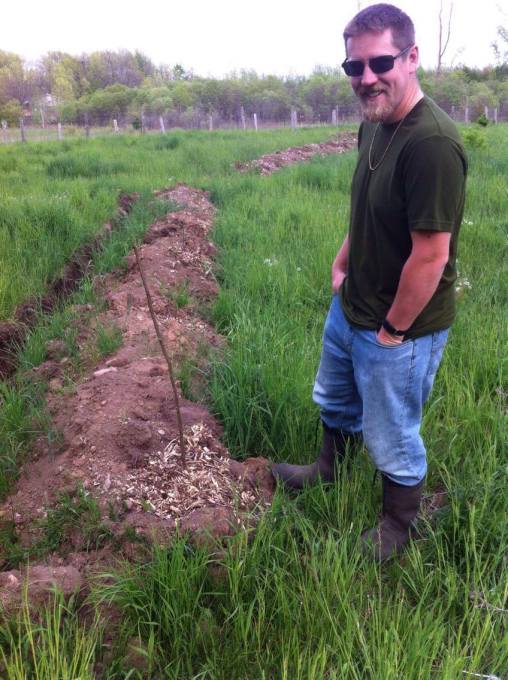Article by: Kyle, Sunnyside Acres
Continued from: Guest Post: Building a Food Forest (Part 2)
Our property, beautiful as it is, does not sport a very wide or diverse variety of trees as it stands currently. Our forest is composed primarily of cedar, maple, and to a lesser extend some ash, apple, and poplar. If we were going to get a successful food forest established, we were going to have to import a lot of the species we were looking for to the site. Then, once we’ve got them established on the farm, we can propagate them easily from there.
After researching a number of different plants commonly utilized in permaculture projects, we’d settled on the list below as our starting point. I’ve included links for most of them if you want to see the information on each:
| Description | Qty |
| Common Black Alder
A fast growing, nitrogen fixing tree good for windbreaks, hedges, firewood, timber. A good pollen and nectar source for beneficial insects. Aides with erosion control and habitat restoration. |
50 |
| Black Locust
Yields very rot-resistant wood good for construction or fuel, has nitrogen fixing properties, and flowers which are excellent food for bees. |
50 |
| American Chinquapin
A dwarf chestnut shrub we’re planting in the back forest area on our property to feed and shelter wildlife such as rabbits, turkey, and deer. |
10 |
| Hybrid Chestnut Castanea Dentata x Castanea Mollissima
A hybrid variety of chestnut tree which combines the American chestnut with an Asian variety known to be resistant to the Chestnut blight which has devastated the chestnut cultivars in North America. |
10 |
| Paw Paw
Fruits are about the size of a potato, have the consistency of a banana, and tastes like a mix of vanilla pudding or banana with hints of mango. Had to include it! |
10 |
| Red Mullberry
A tree that grows berries which are good for fresh eating, baking, juices, syrup, wine making, etc. |
5 |
| Kiwi Actinidia Kolomikta Female one year
Kiwi vines that grow in our climate, which produce fruit that are about the size of a grape but without the fuzzy exterior. You can eat them straight off the vine, and they look and taste inside like a regular kiwi! |
6 |
| Kiwi Actinidia Kolomikta Male one year
These kiwi vines require male pollinators for fruit production. |
3 |
| Assortment of Hazelnut
Edible nuts – raw, dried, or cooked. Can be dried and ground into flour. Or pressed for oil extract. |
10 |
| Honey Crisp Eating Apple
Everyone likes apples! Good for eating, baking, cider, etc.. |
4 |
| Royal Gala Eating Apple
Same as above, just another variety we wanted to try. |
4 |
| Northern Pecan
A slow-growing nut tree which also yields good wood as well as mulch which is rich in Calcium and Phosphorus each fall when they shed their leaves. Plus, pecan pie! |
10 |
| Seaberry plant
Very hardy shrub which can tolerate poor soils, drought, salt. It fixes nitrogen in the soil, improving soil quality making it possible for other less tolerant species to become established in formerly depleted soils. It produces tart, nutrient-dense berries. They’re actually really cool plants. Best to click the link above for a full description.. |
50 |
| Raspberry plants
Because raspberries are delicious! |
15 |
| Blueberry plants
Because blueberries are delicious too (and can be expensive to buy)! |
15 |
| Honey bee Haskap
Sometimes referred to as Honeyberries – Another berry-producing plant suited for fresh eating or baking, wine making, etc. |
3 |
| Borealis Haskap
Sometimes referred to as Honeyberries – Another berry-producing plant suited for fresh eating or baking, wine making, etc. |
3 |
This list would give us a decent starting variety of food-bearing plants, as well as a number of supporting plants which could aid in fertilizing the relatively depleted soils we were looking at planting our food forest in. And a couple of them we threw in there just because we like them and they’re tasty!
Still, if you’ve researched Permaculture you’ll quickly notice that we’ve still got some pieces which are currently unaddressed in the “typical” food forest model seen below:

We’re only touching on a few of these elements in our first phase (mainly canopy/sub-canopy layers), but I’m hoping that as time goes on and the trees become established we will continue to add more varieties and include some of the other layers in the system as well.
So, we placed our order with our supplier and waited. And waited. And waited. Until finally..

Our trees and plants showed up! All 258 of them!
I immediately put in for a few days of vacation from work, and we set to the task of getting everything into the ground as quickly as possible. After having traveled in boxes for the better part of a week, some of the plants looked a little worse for wear and really needed to get settled in to their new home ASAP.

So, we took an inventory of everything, loaded it all into the truck, brought it down to the field where we’d prepared the swales previously, and started getting things put into the ground.
The planting took us almost three full days from start to finish. We had to plant, water, and mulch all 258 plants across a fairly large area which we discovered wasn’t the easiest task.
We needed to load the truck up with buckets of water filled from the barn and bring them down to the field, which was (and continues to be due to the current drought conditions!) the most time consuming piece. We needed to load the truck up with a bunch of mulch (chipped up from the wood left around from the ice storm this past winter) and spread that around each of the planting locations. It made for some very long and busy days!

It was a lot of work, but it’s also the kind of work that leaves you feeling pretty satisfied at the end. We’d put a lot of thought and effort into everything leading up to this point, so it was really nice to finally have everything put into the ground and starting to grow!

These pictures were taken toward the end of May. I’ll try and get out and take some more current pictures for the next article as to how things have been progressing since we planted everything and some of the following steps we’ve taken since then.
More to follow!

To be continued at Guest Post: Building a Food Forest (Part 4)






[…] To be continued at Guest Post: The Permaculture Push (Part 3) […]
LikeLike
[…] To be continued at Guest Post: Building a Food Forest (Part 3) […]
LikeLike